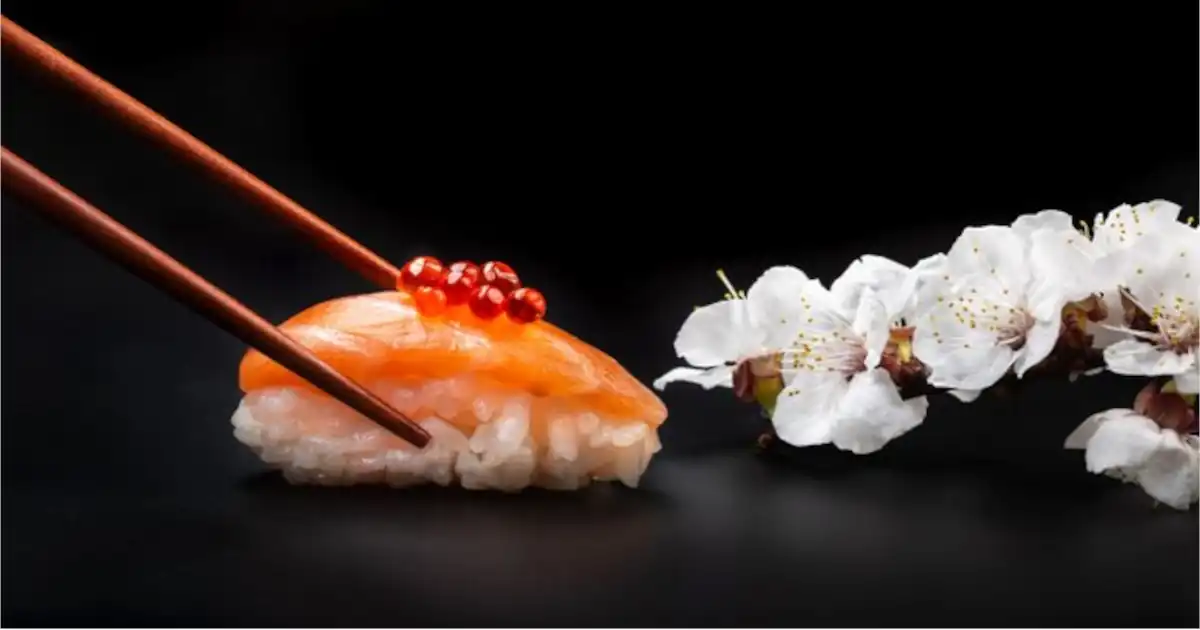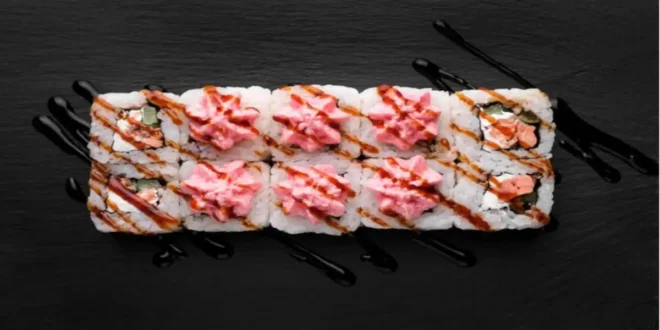Introduction to Sakura Sushi
Sakura sushi, an exquisite fusion of culinary artistry and Japanese tradition, captures the delicate beauty of cherry blossoms. This unique sushi style not only tantalizes the taste buds but also appeals to the eyes, making it a true feast for all the senses. With its origins rooted deeply in Japanese culture, sakura sushi embodies the transient beauty of sakura (cherry blossoms) and the meticulous craft of sushi making. In this article, we will explore the history, ingredients, preparation techniques, and cultural significance of sakura sushi, while also providing tips for making this delightful dish at home.
The Cultural Significance of Sakura
1. The Cherry Blossom Festival
In Japan, cherry blossoms hold a significant place in the hearts of the people. Each spring, cities and towns across the country celebrate Hanami, the cherry blossom festival, where people gather in parks to enjoy picnics beneath blooming sakura trees. This event symbolizes the beauty of life and the fleeting nature of existence, as cherry blossoms bloom for only a short period each year. This cultural backdrop enhances the allure of sakura sushi, which reflects the ephemeral beauty of these blossoms.
2. Symbolism in Japanese Culture
Cherry blossoms represent new beginnings, renewal, and the transient nature of life in Japanese culture. This symbolism resonates with the art of sushi, which combines seasonal ingredients to create dishes that celebrate freshness and harmony. The incorporation of sakura elements in sushi not only enhances the visual appeal but also reinforces the connection to nature and the changing seasons.
The Elements of Sakura Sushi
1. Ingredients
The beauty of sakura sushi lies in its choice of ingredients, which are carefully selected to reflect the colors and flavors of spring. Here are some essential components that make up sakura sushi:
- Sushi Rice: The foundation of any sushi dish, sushi rice is seasoned with rice vinegar, sugar, and salt. For sakura sushi, the rice is often colored with natural ingredients to mimic the soft pink hues of cherry blossoms.
- Nori (Seaweed): Nori is used to wrap sushi rolls. While traditional nori is dark green, variations can be found that incorporate colors that match sakura themes.
- Fish and Seafood: Fresh fish, such as salmon, tuna, and shrimp, are commonly used in sakura sushi. These ingredients should be of the highest quality to ensure the best flavor.
- Vegetables: Seasonal vegetables like cucumber, avocado, and pickled daikon are often included for crunch and freshness. Edible flowers or pink-hued ingredients can also be added to enhance the aesthetic appeal.
- Sakura Leaves: The leaves of the cherry blossom tree are sometimes used in the preparation of sakura sushi. They impart a subtle fragrance and a hint of flavor, adding to the overall experience.
2. Presentation
The presentation of sakura sushi is as important as its taste. Chefs often go to great lengths to create visually stunning dishes that evoke the essence of spring. Here are some presentation tips:
- Color Coordination: Use a palette of soft pinks, greens, and whites to mimic the colors of cherry blossoms. This can be achieved through the use of naturally colored sushi rice, vegetables, and garnishes.
- Garnishing with Edible Flowers: Incorporate edible flowers such as pansies or nasturtiums to add vibrant colors and enhance the visual appeal.
- Themed Plating: Arrange sushi on a plate that resembles a cherry blossom branch, with delicate touches that evoke the beauty of nature.

Making Sakura Sushi at Home
1. Ingredients and Tools
To create your own sakura sushi, gather the following ingredients:
- Sushi Rice (2 cups)
- Rice Vinegar (1/4 cup)
- Sugar (2 tablespoons)
- Salt (1 teaspoon)
- Fresh Fish (salmon, tuna, shrimp)
- Vegetables (cucumber, avocado, pickled daikon)
- Nori Sheets
- Sakura Leaves (optional)
- Edible Flowers (for garnish)
You will also need essential tools:
- Rice Cooker or Pot
- Bamboo Sushi Mat
- Sharp Knife
- Plastic Wrap
- Small Bowl of Water (for wetting hands)
2. Preparing Sushi Rice
- Rinse the Rice: Start by rinsing the sushi rice under cold water until the water runs clear. This removes excess starch and prevents the rice from becoming gummy.
- Cook the Rice: Use a rice cooker or a pot to cook the rice. Follow the instructions for your specific appliance, typically using a ratio of 1:1.2 rice to water.
- Season the Rice: Once the rice is cooked, mix rice vinegar, sugar, and salt in a small bowl until dissolved. Gently fold this mixture into the warm rice, being careful not to mash the grains. Allow the rice to cool to room temperature.
3. Coloring the Rice
To achieve the pink hue reminiscent of cherry blossoms:
- Natural Colorants: Use natural ingredients like beet juice or sakura extract to color the rice. Add a small amount to the rice and mix gently until the desired color is achieved.
4. Assembling Sakura Sushi
- Prepare the Bamboo Mat: Lay a sheet of plastic wrap over the bamboo sushi mat to prevent sticking.
- Add Nori: Place a sheet of nori on the mat, shiny side down.
- Spread the Rice: Wet your hands to prevent sticking and grab a handful of sushi rice. Spread it evenly over the nori, leaving a 1-inch border at the top.
- Layer Ingredients: Place your choice of fresh fish, vegetables, and optional sakura leaves across the center of the rice.
- Rolling the Sushi: Starting from the bottom, roll the bamboo mat forward, pressing gently but firmly to create a tight roll. Use the border of nori to seal the roll.
- Cutting the Sushi: With a sharp knife, slice the sushi roll into bite-sized pieces. Wipe the knife with a damp cloth between cuts to maintain clean edges.
5. Garnishing and Serving
Arrange your sakura sushi on a plate, adding edible flowers for a beautiful presentation. Serve with soy sauce, wasabi, and pickled ginger on the side for an authentic experience.
Health Benefits of Sakura Sushi
Sakura sushi not only delights the senses but also offers various health benefits:
1. Nutrient-Rich Ingredients
- Fish: Rich in omega-3 fatty acids, fish contributes to heart health and brain function.
- Vegetables: Fresh vegetables provide essential vitamins, minerals, and dietary fiber, promoting overall health.
2. Low-Calorie Option
Sushi can be a low-calorie meal option, particularly when made with lean fish and plenty of vegetables. This makes it suitable for those looking to maintain a healthy diet.
3. Mindful Eating
The art of making and enjoying encourages mindfulness, allowing individuals to appreciate the flavors and presentation of each piece. This can lead to a more satisfying dining experience and help regulate portion sizes.
Sakura Sushi in Contemporary Cuisine
1. Modern Twists on Tradition
As culinary innovation continues to thrive, chefs around the world have started experimenting with , incorporating unconventional ingredients and techniques. For example:
- Vegetarian Options: Using ingredients like tofu, sweet potato, or tempura vegetables to create plant-based .
- Fusion Sushi: Blending flavors from other cuisines, such as adding spicy mayo or mango to enhance the taste.
2. Popularity in Global Cuisine
The rising popularity of sushi in various cultures has led to the emergence of in international restaurants. Many establishments now offer sakura-themed dishes during cherry blossom season, attracting food enthusiasts eager to experience this unique culinary art.
Conclusion
Sakura sushi is more than just a meal; it is a celebration of Japanese culture, nature, and artistry. With its stunning presentation and delicate flavors, has captured the hearts of food lovers worldwide. By understanding its origins, ingredients, and preparation techniques, you can appreciate the beauty of and perhaps even create your own version at home. Embrace the elegance of cherry blossom-inspired cuisine and enjoy a culinary journey that pays homage to the fleeting beauty of sakura.
1. What is sakura sushi?
Sakura sushi is a type of sushi that incorporates elements inspired by cherry blossoms, both in flavor and presentation. It often features colorful ingredients and artistic plating.
2. Can I make sakura sushi vegetarian?
Yes, sakura sushi can be made vegetarian by using vegetables, tofu, and plant-based ingredients in place of fish.
3. How do I achieve the pink color in sakura sushi?
You can achieve a pink hue in sakura sushi rice by using natural colorants like beet juice or extract, mixed into the rice.
4. Is sakura sushi served warm or cold?
Sakura sushi is typically served cold or at room temperature, similar to traditional sushi.
5. Where can I find sakura sushi?
Sakura sushi can be found in Japanese restaurants, especially during the cherry blossom season. Many chefs offer seasonal specials featuring sakura-themed dishes.
By following the guidelines and inspiration outlined in this article, you can create a memorable dining experience centered around, bringing a taste of Japan’s cherished cherry blossom tradition into your own home. Enjoy the process of making and savoring this beautiful cuisine, celebrating the beauty of nature with every bite.
Frequently Asked Questions (FAQs)
What makes sakura sushi unique compared to traditional sushi?
Sakura sushi stands out from traditional sushi primarily due to its aesthetic appeal and the incorporation of cherry blossom elements. This style often features naturally colored rice and seasonal ingredients that reflect the beauty of spring. The visual presentation is designed to evoke the delicate nature of cherry blossoms, making each dish a feast for the eyes as well as the palate.
Can I enjoy sakura sushi if I have dietary restrictions?
Yes, sakura sushi can be tailored to accommodate various dietary restrictions. For those following a vegetarian or , sushi can be made using plant-based ingredients such as tofu, vegetables, and rice. Additionally, gluten-free options can be created by using specific rice varieties and avoiding traditional soy sauce.
What are some common ingredients used in sakura sushi?
Sakura sushi typically includes sushi rice, fresh fish (like salmon or tuna), seasonal vegetables (such as cucumber and avocado), and sometimes leaves. The rice may also be flavored or colored to reflect the pink hues of cherry blossoms, enhancing both flavor and presentation.
How can I make sakura sushi at home?
To prepare sakura sushi at home, start by cooking sushi rice and seasoning it with rice vinegar, sugar, and salt. You can then color the rice using natural ingredients like beet juice. Assemble the sushi by layering the rice, fish, and vegetables on nori, then roll it tightly using a bamboo mat. Finally, slice the rolls and serve with garnishes for an appealing presentation.
Is sakura sushi a seasonal dish?
While sakura sushi can be enjoyed year-round, it is particularly popular during the cherry blossom season in spring. Many chefs and restaurants create special menus to celebrate this time, incorporating sakura-inspired dishes that highlight the beauty and symbolism of the blossoms.
Where can I find sakura sushi outside of Japan?
Sakura sushi has gained popularity in many parts of the world, especially in Japanese restaurants that embrace seasonal menus. You can often find this delicacy in urban areas with a vibrant culinary scene or during cherry blossom festivals where chefs showcase their creative interpretations of this beautiful dish.
READ ALSO: Hobart Pathology: A Comprehensive Overview
 Touch Blog
Touch Blog



